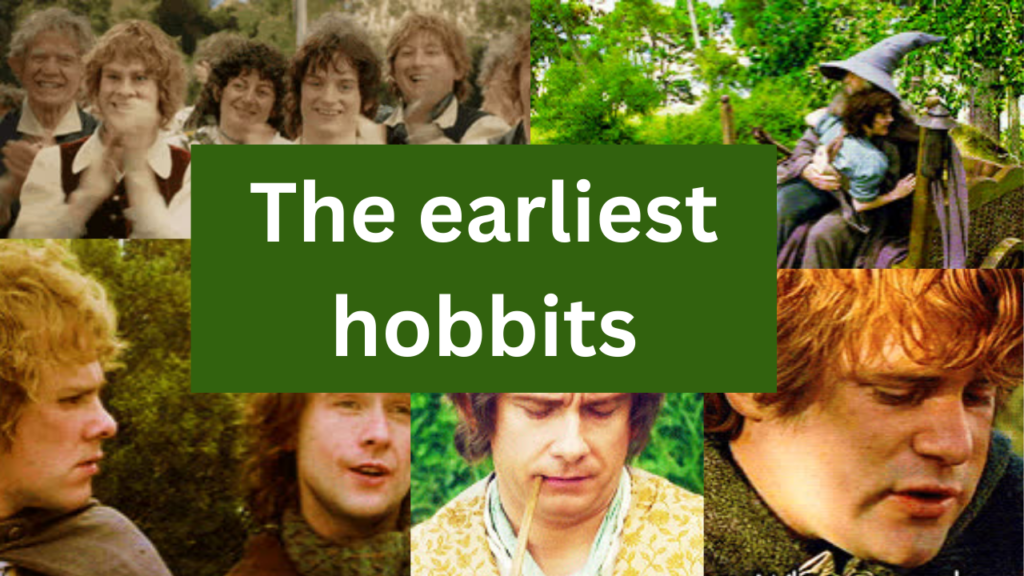
It is commonly stated that Tolkien made hobbits a reflection of himself, which could be evident whether intentional or not.
“On a blank leaf I scrawled:
‘In a hole in the ground there lived a hobbit.’
I did not and do not know why.” (Letters)
Tolkien’s (generation of) idea of hobbits
The first edition of The Hobbit is known to have come out in 1937. While there are speculations that hobbits were inspired by other aspects, hobbits as their own were created by Tolkien. By October 15, 1937, it was revealed that The Hobbit was in the process of publication, while earlier that year on May 11, Allen & Unwin had told Tolkien they had interested one of the outstanding firms in American publishers for the book and asked for his own illustrations.
“I have received one postcard, alluding I suppose to the Times’ review: containing just the words: sic hobbitur ad astra.” (Letter # 17)
…or “thus it is hobbited to the stars.” (Latin)
He also had the concept of hobbits all figured out, though the letter would reveal that by then he would have gotten a letter from his publisher Unwin, who had just sent a copy of The Hobbit to Richard Hughes.
Unwin would warn Tolkien that “a large public would be clamoring next year to hear more from you about Hobbits!” (Letter # 17), which we would find later in Lord of the Rings.
Hobbits development in Middle-earth
They were supposed to be a branch of the human race, with the earliest of them showing up sometime in the Third Age.
“Their earliest tales seem to glimpse a time when they dwelt in the upper vales of Anduin, between the eaves of Greenwood the Great and the Misty Mountains. Why they later undertook the hard and perilous crossing of the mountains into Eriador is no longer certain.” (LOTR, “Prologue”)
There are three types of hobbits: the Harfoots, Stoors, and Fallohides – each entering in that order. This had occurred before the crossing of the mountains into Eriador by the latter.
The Harfoots were browner in skin, shorter and smaller – and they had more to do with the Dwarves than the other two types. They started moving west early going into Weathertop. They were most normal and representative, as well as the most numerous, and more inclined to settle into one place.
The Stoors were broader and heavier in build and lingered long by the Great River Anduin and were less shy of Men. They came after the Harfoots and followed the course of the Loudwater southwards, and would dwell there for a short period of time before moving northwards.
Lastly, the Fallowhides, such as the Tooks and Masters of Buckland, came afterwards being the least numerous and the northerly branch. Thus it can be stated that most of the hobbits you see in Lord of the Rings fell into this category. They were more friendly with the Elves and were more skillful in language and song than crafts, and preferred hunting. They would cross the mountains north of Rivendell and go down the river Hoarwell to Eriador to mingle with the other kinds.
They would find the Men and Elves west of Eriador, between the Misty Mountains and the Mountains of Lune, with a remnant still there in the Dúnedain. However, such earlier settlements were long forgotten by the time of The Hobbit or Bilbo’s time.
Shire-reckoning
In 1601 TA, the Fallohide brothers, Marcho and Blancho went from Bree to Argeleb the High King in Fornost, crossing the brown river Baranduin with other hobbits following them passing the Bridge of Stonebows taking all the land to dwell between the river and the Far Downs. They were asked to keep the Great Bridge in repair and acknowledge the lordship of Argeleb II.
“Thus began the shire-reckoning, for the year of the crossing of the Brandywine (as the Hobbits turned the name) became Year One of the Shire, and all later dates were reckoned from it.” (LOTR, “Prologue”)
As a result the years of the Third Age would be found by adding 1600 to the dates of Shire-reckoning.
“At once the western Hobbits fell in love with their new land, and they remained there, and soon passed once more out of the history of Men and of Elves. While there was still a king they were in name his subjects, but they were, in fact, ruled by their own chieftains and meddled not at all with events in the world outside.” (LOTR, “Prologue”)
The Hobbits took the land for their own with the Last Battle of Fornost with the Witch-king of Angmar, choosing their own chiefs a Thain to hold the authority of the king that was gone. They prospered and multiplied for a thousand years after the Dark Plague in SR 37, until the disaster of the Long Winter and famine were thousands perished.
But more of them came back in the Days of Dearth (1158-1160) and…
“The land was rich and kindly, and though it had long been deserted when they entered it, it had before been well tilled, and there the king had once had many farms, cornlands, vineyards, and woods.” (LOTR, “Prologue”)


